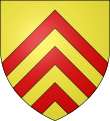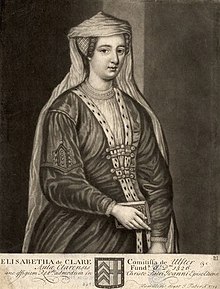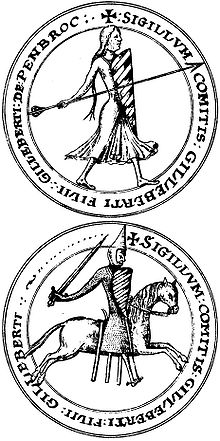de Clare
| House of Clare | ||
|---|---|---|
| Noble House | ||
 | ||
| Parent house | House of Normandy | |
| Country | England
| |
| Founder | Style(s) | Earls, Barons, and Knights |
| Estate(s) | Various Earldoms, Baronies and over 190 Manorial Lordships | |
The House of Clare was a prominent
They were descended from
The de Clares ranked among the greatest baronial houses of the early Middle Ages and were the proprietors of the monumental Caerphilly Castle, Pembroke Castle, Castell Coch, and over 190 manors in England.[1][2]
Origins
Earldoms

On his death, Richard's English estates passed to his son
The son of Gilbert Fitz Gilbert de Clare, Earl of Pembroke, was
The family continued to hold both Earldoms until the early 14th century, when Gilbert de Clare, 8th Earl of Gloucester died without issue and the Earldoms became extinct, while his lands were divided among several sisters. Richard de Clare, a member of a junior line that had become lords of Thomond, in Ireland, would be summoned to Parliament in 1309 and hence is held to have been made Lord Clare. But, the death of his infant son in 1321, shortly after his own death, brought an end to the last of the lines typically called de Clare, though the male line persisted at least a century later in the Barons FitzWalter.
Coat of arms

The early Clares appear to have used a coat of arms that was chevronny, as seen in the seals of Gilbert, 1st Earl of Pembroke, and of his niece, Rohese, Countess of Lincoln. Richard 'Strongbow', 2nd Earl of Pembroke, would simplify this to a coat with three chevronels, matching the three red chevrons on a gold background that would be the arms of the Clare Earls of Hertford.[11]
Family tree
| Tree of Clare | |||||||||||||||||||||||||||||||||||||||||||||||||||||||||||||||||||||||||||||||||||||||||||||||||||||||||||||||||||||||||||||||||||||||||||||||||||||||||||||||||||||||||||||||||||||||||||||||||||||||||||||||||||||||||||||||||||||||||||||||||||||||||||||||||||||||||||||||||||||||||||||||||||||||||||||||||||||||||||||||||||||||||||||||||||||||||||||||||||||||||||||||||||||||||||||||||||||||||||||||||||||||||||||||||||||||||||||||||||||||||||||||||||||||||||||||||||||||||||||||||||||||||||||||||||||||||||||||||||||||||||||||||||||||||||||||||||||||||||||||||||||||||||||||||||||||||||||||||||||||||||||||||||||||||||||||||||||||||||||||||||||||||||||||||||||||||||||||||||||||||||||||||||||||||||||||||||||||||||||||||||||||||||||||||||||||||||||||||||||||||||||||||||||||||||||||||||||||||||||||||||||||||||||||||||||||||||||||||||||||||||||||||||||||||||||||||||||||||||||||||||||||||||||||||||||||||||||||||||||||||||||||||||||||||||||||||||||||||||||||||||||||||||||||||||||||||||||||||||||||
|---|---|---|---|---|---|---|---|---|---|---|---|---|---|---|---|---|---|---|---|---|---|---|---|---|---|---|---|---|---|---|---|---|---|---|---|---|---|---|---|---|---|---|---|---|---|---|---|---|---|---|---|---|---|---|---|---|---|---|---|---|---|---|---|---|---|---|---|---|---|---|---|---|---|---|---|---|---|---|---|---|---|---|---|---|---|---|---|---|---|---|---|---|---|---|---|---|---|---|---|---|---|---|---|---|---|---|---|---|---|---|---|---|---|---|---|---|---|---|---|---|---|---|---|---|---|---|---|---|---|---|---|---|---|---|---|---|---|---|---|---|---|---|---|---|---|---|---|---|---|---|---|---|---|---|---|---|---|---|---|---|---|---|---|---|---|---|---|---|---|---|---|---|---|---|---|---|---|---|---|---|---|---|---|---|---|---|---|---|---|---|---|---|---|---|---|---|---|---|---|---|---|---|---|---|---|---|---|---|---|---|---|---|---|---|---|---|---|---|---|---|---|---|---|---|---|---|---|---|---|---|---|---|---|---|---|---|---|---|---|---|---|---|---|---|---|---|---|---|---|---|---|---|---|---|---|---|---|---|---|---|---|---|---|---|---|---|---|---|---|---|---|---|---|---|---|---|---|---|---|---|---|---|---|---|---|---|---|---|---|---|---|---|---|---|---|---|---|---|---|---|---|---|---|---|---|---|---|---|---|---|---|---|---|---|---|---|---|---|---|---|---|---|---|---|---|---|---|---|---|---|---|---|---|---|---|---|---|---|---|---|---|---|---|---|---|---|---|---|---|---|---|---|---|---|---|---|---|---|---|---|---|---|---|---|---|---|---|---|---|---|---|---|---|---|---|---|---|---|---|---|---|---|---|---|---|---|---|---|---|---|---|---|---|---|---|---|---|---|---|---|---|---|---|---|---|---|---|---|---|---|---|---|---|---|---|---|---|---|---|---|---|---|---|---|---|---|---|---|---|---|---|---|---|---|---|---|---|---|---|---|---|---|---|---|---|---|---|---|---|---|---|---|---|---|---|---|---|---|---|---|---|---|---|---|---|---|---|---|---|---|---|---|---|---|---|---|---|---|---|---|---|---|---|---|---|---|---|---|---|---|---|---|---|---|---|---|---|---|---|---|---|---|---|---|---|---|---|---|---|---|---|---|---|---|---|---|---|---|---|---|---|---|---|---|---|---|---|---|---|---|---|---|---|---|---|---|---|---|---|---|---|---|---|---|---|---|---|---|---|---|---|---|---|---|---|---|---|---|---|---|---|---|---|---|---|---|---|---|---|---|---|---|---|---|---|---|---|---|---|---|---|---|---|---|---|---|---|---|---|---|---|---|---|---|---|---|---|---|---|---|---|---|---|---|---|---|---|---|---|---|---|---|---|---|---|---|---|---|---|---|---|---|---|---|---|---|---|---|---|---|---|---|---|---|---|---|---|---|---|---|---|---|---|---|---|---|---|---|---|---|---|---|---|---|---|---|---|---|---|---|---|---|---|---|---|---|---|---|---|---|---|---|---|---|---|---|---|---|---|---|---|---|---|---|---|---|---|---|---|---|---|---|---|---|---|---|---|---|---|---|---|---|---|---|---|---|---|---|---|---|---|---|---|---|---|---|---|---|---|---|---|---|---|---|---|---|---|---|---|---|---|---|---|---|---|---|---|---|---|---|---|---|---|---|---|---|---|---|---|---|---|---|---|---|---|---|---|---|---|---|---|---|---|---|---|---|---|---|---|---|---|---|---|---|---|---|---|---|---|---|---|---|---|---|---|---|---|---|---|---|---|---|---|---|---|---|---|---|---|---|---|---|---|---|---|---|---|---|---|---|---|---|---|---|---|---|---|---|---|---|---|---|---|---|---|---|---|---|---|---|---|---|---|---|---|---|---|---|---|---|---|---|---|---|---|---|---|---|---|---|---|---|---|---|---|---|---|---|---|---|---|---|---|---|---|---|---|---|---|---|---|---|---|---|---|---|---|---|---|---|---|---|---|---|---|---|---|---|---|---|---|---|---|---|---|---|---|---|---|---|---|---|---|---|---|---|---|---|---|---|---|---|---|---|---|---|---|---|---|---|---|---|---|---|---|---|---|---|---|---|---|---|---|---|---|---|---|---|---|---|---|---|---|---|---|---|---|---|---|---|---|---|---|---|---|---|---|---|---|---|---|---|---|---|---|---|---|---|---|---|---|---|---|---|---|---|---|---|---|---|---|---|---|---|---|---|---|---|---|---|---|---|---|---|---|---|---|---|---|
| |||||||||||||||||||||||||||||||||||||||||||||||||||||||||||||||||||||||||||||||||||||||||||||||||||||||||||||||||||||||||||||||||||||||||||||||||||||||||||||||||||||||||||||||||||||||||||||||||||||||||||||||||||||||||||||||||||||||||||||||||||||||||||||||||||||||||||||||||||||||||||||||||||||||||||||||||||||||||||||||||||||||||||||||||||||||||||||||||||||||||||||||||||||||||||||||||||||||||||||||||||||||||||||||||||||||||||||||||||||||||||||||||||||||||||||||||||||||||||||||||||||||||||||||||||||||||||||||||||||||||||||||||||||||||||||||||||||||||||||||||||||||||||||||||||||||||||||||||||||||||||||||||||||||||||||||||||||||||||||||||||||||||||||||||||||||||||||||||||||||||||||||||||||||||||||||||||||||||||||||||||||||||||||||||||||||||||||||||||||||||||||||||||||||||||||||||||||||||||||||||||||||||||||||||||||||||||||||||||||||||||||||||||||||||||||||||||||||||||||||||||||||||||||||||||||||||||||||||||||||||||||||||||||||||||||||||||||||||||||||||||||||||||||||||||||||||||||||||||||||
Notes
Bibliography
- J. C. Ward, "Fashions in monastic endowment: the foundations of the Clare family, 1066–1314", Journal of Ecclesiastical History, vol. 32.4 (1981), p. 427–451.
- J. C. Ward, "Royal service and reward: the Clare family and the crown, 1066–1154", Anglo-Norman Studies, vol. 11 (1988), p. 261–278.
- Michael Altschul, A Baronial Family in Medieval England: The Clares, 1217–1314, The Johns Hopkins Press, Baltimore, 1965. See online summary.
References
- ^ Queen Mary, University of London, The estates of the Clare Family 1066-1317. Ward, Jennifer Clare
- ^ Page, W. (1927) Parishes: Chilton. A History of the County of Buckingham: Volume 4. Ed. London, England: Victoria County History.
- Oxford Dictionary of National Biography, online by subscription.
- ^ Suffolk return of the Domesday Survey (c. 1086) (ed. A. Rumble, Suffolk, 2 vols (Chichester, 1986), 67 ~ 1
- ^ a b Round 1911.
- ^ J. Horace Round (1901), "The Companions of the Conqueror", Monthly Review, vol. 3, pp. 91-111
- ^ George Baker (1822), History and Antiquities of the County of Northampton, vol. 1, pp. 306, 379
- ^ R. H. C. Davis, King Stephen (1977), p. 136, and p. 129.
- ^ Frank Barlow, The Feudal Kingdom of England, 1042–1261 (4th edition 1988), p. 213.
- ^ Round 1887.
- ^ J. H. Round, "The Introduction of Armorial Bearings into England", The Archaeological Journal, volume 51, pp 43-48 [1]
- Attribution
- Round, John Horace (1911). . In Chisholm, Hugh (ed.). Encyclopædia Britannica. Vol. 6 (11th ed.). Cambridge University Press. pp. 423–424.
 This article incorporates text from a publication now in the public domain: Round, John Horace (1887). "Clare, de". In Stephen, Leslie (ed.). Dictionary of National Biography. Vol. 10. London: Smith, Elder & Co. pp. 375–376.
This article incorporates text from a publication now in the public domain: Round, John Horace (1887). "Clare, de". In Stephen, Leslie (ed.). Dictionary of National Biography. Vol. 10. London: Smith, Elder & Co. pp. 375–376.
